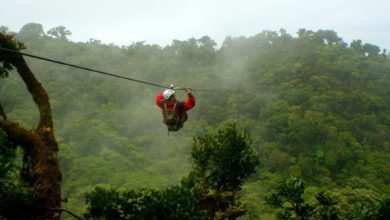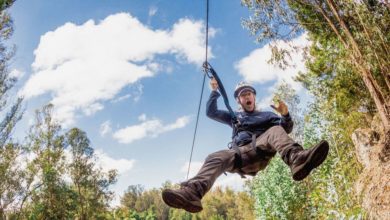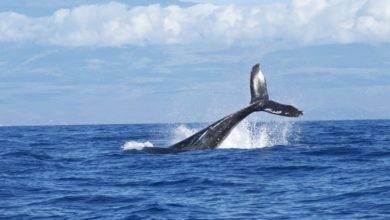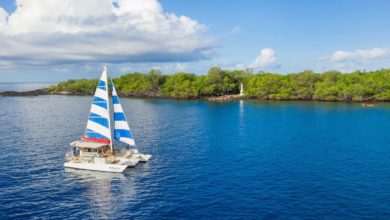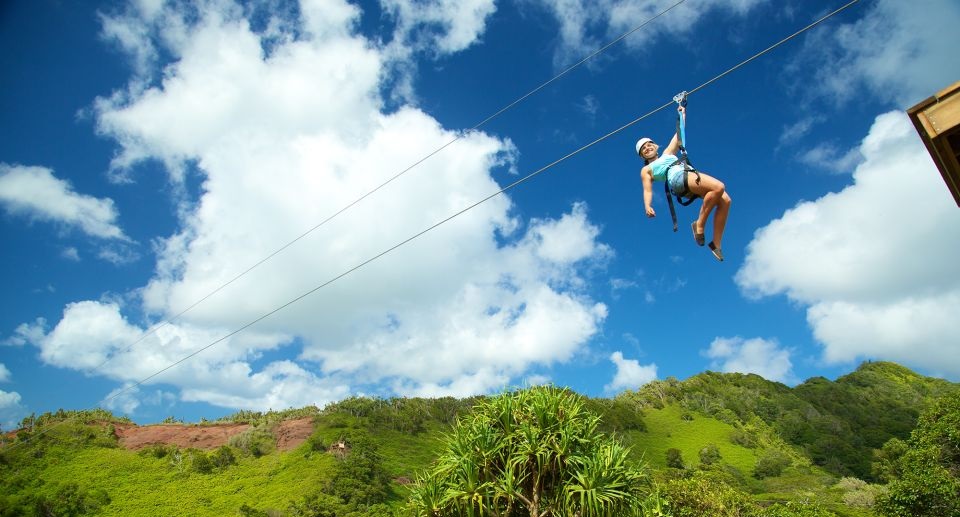
One of the biggest reasons why Hawaii is such a tourist hot spot is due to its breathtaking scenery and excellent climate for exploring outdoors.
However, we feel that no trip is complete if you aren’t taking advantage of the thrills and adventures it has to offer.
If you are looking to pack your schedule full of fun and adrenaline, you have to go ziplining! We’ve taken it upon ourselves to find the top selections available. Without further ado, we bring you the top big island ziplining tours!
Be sure to see our reviews of Big Island helicopter tours, Big Island volcano tours and Big Island snorkel tours.
Best Big Island Zipline Adventures
| Big Island Kohala Canopy Zipline Adventure | Big Island Zipline Over KoleKole Falls | Big Island Zipline Adventure | |
|---|---|---|---|
 | |||
 |  |  |
|
| Departure: | 55-515 Hawi Rd, Hawi, HI 96719 | 28-1692 Old Mamalahoa Hwy, Honomu, HI 96728 | 31-240 Old Mamalahoa Hwy, Hakalau, HI 96710 |
| Start: | 9:00, 10:00 AM, 12:30, 1:00 PM | Between 9:30 AM & 3:30 PM | 10:00, 11:00 AM, 1:00, 2:00 PM |
| Duration: | 3 hours | 2.5 hours | 2.5 hours |
| Includes: | All necessary equipment (helmet, gloves and harness), water, taxes, fees | All necessary equipment (helmet, gloves and harness), professional instructor | Refreshments, guide, equipment, Botanical Gardens self-guided tour, souvenir photos FREE! |
Quick Answer: The 3 Best Rated Big Island Ziplining Tours
- Big Island Kohala Canopy Zipline Adventure
- Big Island Zipline Over KoleKole Falls
- Big Island Zipline Adventure – 2 1/2 hours
Big Island Ziplining Reviews
1. Big Island Kohala Canopy Zipline Adventure
- Duration: 3 hours
- Departure: 55-515 Hawi Rd, Hawi, HI 96719
- Departure Time: 9:00 AM, 10:00 AM, 12:30 PM, 1:00 PM
- Includes: All necessary equipment (helmet, glove and harness), water, taxes, fees
Our next tour is a bit longer, lasting 3 hours, however there’s quite a bit to do so you’ll appreciate the extra time. The Big Island Kohala Canopy Zipline Adventure starts out in the north of Kohala where you’ll venture in the treetops and over all sorts of suspension bridges, platforms, and other thrill-inducing features.
With experts at the reins, you can count on you and the rest of your group remaining safe throughout the entire time.
Located by a farm, the guides are very knowledgeable about its history, culture, the animals, macadamia nuts, and just about any other questions you may have about the area.
They’re great at helping guests prepare for the ziplines, and will show you exactly how you should glide. While they place safety at the forefront of their operation, they manage to do so in a way that’s fun and entertaining.
This course is one of the most unique we’ve come across, and offers 360 views of the Kohala countryside. With the ability to control the speed and orientation of the zipline, this makes many inexperienced zippers feel more confident.
Once you get used to it, you’re sure to never want to leave! The course is very quiet, so you can just focus on ziplining and the picture-perfect nature scenes and animals around you.
More Information & Tour Booking
100% refund for cancellations within 24 hours of tour experience
Other Experiences You May Enjoy:
2. Big Island Zipline Over KoleKole Falls
- Duration: 2.5 hours
- Departure: 28-1692 Old Mamalahoa Hwy, Honomu, HI 96728
- Departure Time: Between 9:30 AM & 3:30 PM
- Includes: All necessary equipment, professional instructor
Speaking of adrenaline, your body will surely be pumping it out on this tour! Ziplining alone is quite a rush, but take that line and cross it over some of the most scenic falls in the world and you have one of the most fun experiences for the entire family! The Big Island Zipline Over KoleKole Falls is consistently raved about, and it’s no secret why.
This 2.5-hour tour takes place in Hilo, spanning 7 lines. From up on the ridgelines, you’ll even get to see views of the Pacific! Designed for all levels of experience, you can rest assured that everyone will feel comfortable and safe. We recommend starting at the shortest line and working your way up if it’s your first time.
You should know that the 7th line is one of the longest in the country, spanning across a 250-foot waterfall! Soaring seamlessly over the green rainforests and gushing water is certainly unlike anything else! It’s definitely a wonderful way to get everyone to have some fun and get in some fresh air and sunshine while trying something new!
The guides are very knowledgeable as well, and will teach you all about native Hawaiian culture, sustainable practices that are essential to the area, and its history. If you’d like, you can even try some of the local fruits!
More Information & Tour Booking
100% refund for cancellations within 24 hours of tour experience
3. Big Island Zipline Adventure
- Duration: 2.5 hours
- Departure: 31-240 Old Mamalahoa Hwy, Hakalau, HI 96710
- Departure Time: 10:00 AM, 11:00 AM, 1:00, 2:00 PM
- Includes: Local taxes, refreshments, professional guide, use of full body harness, rigging and helmet, water and light snacks, Botanical Gardens self-guided tour, souvenir photos FREE!
Next, we bring you the Big Island Zipline Adventure. This 2.5-hour activity will have you soaring through the lush rainforest with 8 different ziplines to choose from. Having been in operation for decades now, they clearly know what they’re talking about and ensure lots of fun while you stay safe!
Located at Botanical World, it’s more than just ziplining, though! Their gardens are full of interesting, varied plants and trees. The property is packed with all kinds of rainforest trails and different sights to see! Some crowd favorites are Kamaee Falls and the “real-life” maze! Oh, and did we mention the suspension bridge located in the heart of the cool rainforest?
You may even get the chance to see some rare, local animals that you wouldn’t see anywhere else! You’ll get to leisurely check out the area with an experienced guide to lead you, that knows just about everything about the property and its history.
Due to the varying lengths of lines, you’ll have the chance to build up experience and courage to the longer ones. The half-mile race past the infamous 250-foot tall falls is definitely an adventure you’ll want to do again and again!
With varying time slots, it’s nice and convenient for trying to plan out your day. However, first thing in the morning is always fun because it’s sure to wake you up and is a great way to start out a day of sightseeing! We also really appreciated the fact that they included complimentary souvenir photos which are perfect for framing or hanging on the fridge!
More Information & Tour Booking
100% refund for cancellations within 24 hours of tour experience
Big Island Travel Guide
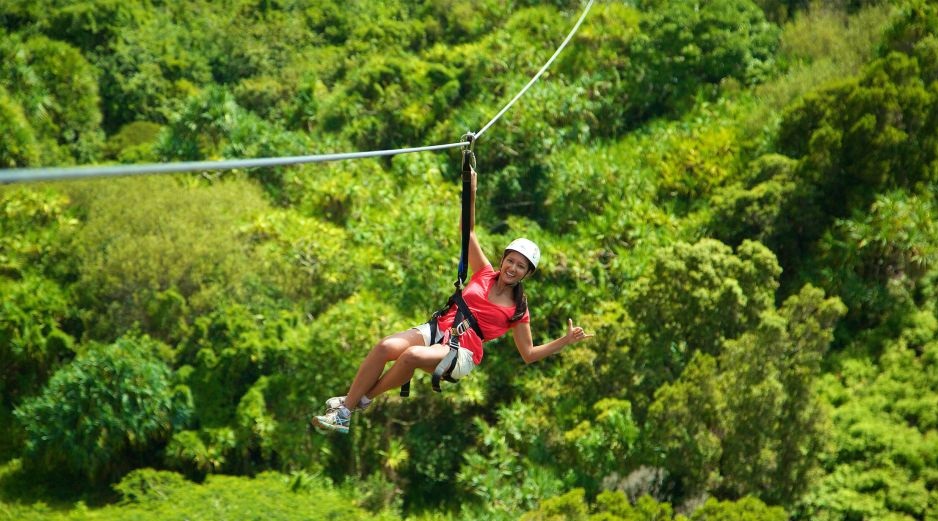
The Big Island is the best Hawaiian island to visit by far. Why? Because it boasts active volcanoes, the world’s tallest mountain, 5 Marine Life Conservation Districts, and more wilderness and variety than any other island in the Hawaiian Archipelago.
Given its name, you won’t be surprised to learn that the Big Island is the largest island in the State of Hawaii. But this isn’t its official name. The Big Island is really the Island of Hawaii. However, calling it the Big Island helps to distinguish it from the state and avoid confusion.
It really is a big island. In fact, it’s the 3rd largest island in Polynesia. Only the two main islands of New Zealand are larger. You may think the island gained its name from the name of the state. In fact, the state was named after this island.
Although the Big Island now has the lowest population density of the four main islands in the Hawaiian archipelago, historically it was the most powerful. In 1795, Kamehameha the Great from Hawaii untied most of the islands under his rule and named his extended kingdom after his home island.
Today the low population density and many fascinating natural attractions on and around the Island of Hawaii make it the premiere Hawaiian destination for anyone who wishes to experience the full scope of Mother Nature’s variety, beauty, and majesty.
Airports & Entry
Most visitors come to the Island of Hawaii by air. You can fly directly from the mainland US and Canada to Hilo International Airport (ITO) in the east or Ellison Onizuka Kona International Airport (KOA) in the west.
Alternatively, you can fly to Daniel K. Inouye Honolulu International Airport (HNL) in Oahu and then take a short half-hour connecting flight to the Big Island. Most direct flights are from large cities on the western seaboard. However, there are also direct flights to KOA from Tokyo.
Although only 185,000 people live on the island, KOA saw 4 million and ITO 1.4 million passengers in the immediate each year pre-COVID. The vast majority of these are tourists.
If you intend to explore the whole island, it’s a good idea to arrange to arrive at one airport and depart at the other. This enables you to tour the whole island with no need to backtrack. However, many visitors stick to one of the main resorts, such as Kailua-Kona.
Before choosing your arrival airport, consider where you are going to stay. This will depend upon what you most want to see on the Big Island. It makes sense to arrive at the airport closest to your hotel.
KOA is a modern airport with 3 terminals, only 2 used for international travellers. ITO is much smaller with a single large terminal. Both airports offer a limited range of shops and restaurants focused on tourism. For example, there are gift shops, lei stands, and newsstands. Opening hours are arranged around flight arrival and departure times.
Eight major car rental companies operate out of both airports: Alamo, Avis, Budget, Dollar, Enterprise, Hertz, National, and Thrifty. All the rental agencies have rental bases that are reached by a shuttle bus from the airports.
It is advisable to book vehicle rental in advance to save time and ensure you get the vehicle you want. If you plan to pick up at one airport and drop at the other, you must tell them in advance to avoid extra charges.
If you don’t want to hire a vehicle, you can take a taxi into Kailua for around $25. There is a much cheaper option — The Hele-On Bus operated by the Hawaii County Mass Transit Agency. However, they only operate a limited service.
Traveling in the time of Covid
Like many other destinations worldwide, tours and visitor attractions in the Island of Hawaii have adopted special procedures.
Wearing a mask in mandatory in many locations. You will be expected to supply your own mask and wear it when you enter public buildings.
Keep your distance from other visitors who are not in your family group or bubble. You will be expected to keep your distance inside minibuses and other vehicles and when seated in restaurants.
At the time of writing, the State of Hawaii welcomes visitors but requires pre-travel testing for Covid-19. You can obtain the most up-to-date information directly from the State of Hawaii Portal.
Eco-Tourism and Sustainability in the Big Island
The Hawaiian Archipelago offers many areas of outstanding natural beauty and protected wildlife areas you can explore. In order to maintain this wonderful place for future generations, many of the local tour companies operate eco-friendly tours.
When considering the tours we review on the World Travel Guides website, note that there are often eco-friendly options that empower you to become a more sustainable traveler. This is especially true around the islands of Hawaii. Take care of our world and it will take care of our children.
Planning Tips
It’s always best to be prepared. Here are 5 tips to help you make the most of your stay on the Big Island.
Tip #1: If you want to see whales, go in winter
During the summer, humpback whales feed and congregate around Alaska. In winter, they migrate south to mate and calve. From mid-December to mid-April, there are an abundance of whale sightings around the Big Island.
Between 10 and 12 thousand whales congregate in these tropical waters. Whales are often visible at a distance from the beaches and will circle any small boats that approach their pods. Winter is the best time to whale watch in Hawaii.
Tip #2: Take your time to appreciate all that the Island of Hawaii has to offer
Perhaps you only want to see the whales or surf in the sunshine, but there’s a lot more to see and do on the Big Island.
Don’t miss the opportunity to explore Hawai’i Volcanoes National Park, experience a traditional luau, and visit Hulihe’e Royal Palace in historic Kailua-Kona. See the information on Nightlife and Attractions below.
Tip #3: Book Big Island tours in advance, especially during winter
The Big Island is a popular destination for tourists, so tours quickly sell out. Book in advance to avoid disappointment. You wouldn’t be able to forgive yourself if you went all that way only to miss your opportunity to whale watch because the tours were full.
Since many tours offer free refunds up to 24 hours before the activity begins, you’re not taking a risk if you book before you go. Just check the refund policy of each tour before you book.
Tip #4: Take summer clothes and raincoats
Because the Big Island is tropical, you need to pack summer clothes. However, don’t forget it also rains a lot on the island.
Light raincoats are an excellent idea. If you intend to visit the observatories on Mauna Kea, you will definitely need a jacket.
And if you plan to visit a plush Martini lounge or attend a luau, you should bring something a bit smarter for those special occasions.
Tip #5: Buy traditional local craft souvenirs
If you want to take home something unique, check out the Volcano Art Center inside Hawai’i Volcanoes National Park.
Over 200 local Hawaiian artists contribute to this store, so you can find and original arts and crafts that will make a unique souvenir of your visit to the Island of Hawai’i.
Restaurants & Eating Out
The Big Island not only has a unique ecosystem with plants not found in the other 49 States, but it also boasts an uninterrupted cultural history.
That means during your stay you have the unique opportunity to taste genuine Polynesian food untainted by European colonial influences.
Because the Big Island is surrounded by abundant marine life, it’s no surprise many restaurants feature seafood on their menus. A popular dish is Opakapaka, which is crimson snapper either steamed, baked or grilled.
Monchong is a deep-water fish marinaded and grilled. Raw tuna is a favorite with the locals and is found in traditional foods like Poke.
Poke is like Japanese Sashimi but with the raw fish served in hearty chunks rather than thin slices.
Something unique to the Hawaiian Islands is luau food cooked in an earth oven called an imu. A tasty example of luau food is Laulau, made with pork, chicken, or fish.
The selected meat is wrapped in taro leaves and then cooked inside the imu for hours until it grows soft with a smoky taste. Delicious!
While many North Americans might consider either bread or potato to be their staple food during meals, on Maui taro is the staple root crop.
Taro is most often consumed as Poi, a thick paste that is either baked or steamed. Poi is slightly sour due to fermentation during its preparation.
And for dessert, why not try some Banana-Apple Fruit, Breadfruit, or Kulolo. Banana-Apple is a common fruit eaten cold or hot. Breadfruit is melon-sized and is served boiled, deep-fried, baked, or steamed.
Kulolo is steamed taro pudding. Yes! Taro is a versatile root.
Nightlife & Entertainment
This Big Island can’t offer the same nightlife and entertainments as Honolulu, but the large quantity of tourists passing through ensure that there are plenty of night spots where you can let your hair down.
Much like the resorts and hotels, the nightlife tends to be clustered along short sections of the east coast and the west coast. On the eastern side, most of the nightlife is found in Hilo. There you will find low key establishments frequented by locals and visitors alike. This is the best area for a quiet night and meeting friends.
On the west coast, the nightlife focuses on Kailua-Kona. There you will find a much larger range of options, from relaxed bars to elegant cocktail bars and lively nightclubs. The beach bars on this side of the island are the best place to witness an amazing sunset while you’re sipping a delicious cocktail.
But while you are in Hawaii, you really should attend at least one traditional luau. That’s a special Hawaiian evening party where you can hear local songs, watch amazing traditional performances, and eat luau foods.
If you go to an organised luau, you can expect a lei greeting, watch the Imu Ceremony (cooking a pig in an earth oven), join in a Hula Dance, and maybe play some traditional games. The highlight is a show by Polynesian performers who re-enact traditional sagas to educate and entertain you about the mythical origins of the Hawaiian Islands.
One of the most popular luaus is the Island Breeze Luau held in an historically significant location — the grounds of King Kamehameha’s Palace in Kailua-Kona. This king was responsible for unifying most of the State of Hawaii into a single kingdom. This luau pulls out all the stops, with an outrigger boat landing, a royal procession, and a fire knife dance.
Getting Around
The easiest and simplest way to get around the Big Island is to rent a car. There are vehicle rental facilities at both international airports. With your own car, you can go where you want to go when you want to go there.
The Hele-On Bus operated by the Hawaii County Mass Transit Agency is an option. However, because of the Island of Hawaii’s relatively low population density and large area, the public bus services are relatively infrequent and don’t go everywhere.
When driving around the island, bear in mind that the speed limits are lower than in the mainland US. Typical speed limits between settlements are 45 mph or 55 mph. When planning your journey, take the lower speed limit and the winding roads into account.
Note there are some locations you cannot reach with a rental car. Your rental contract will most likely forbid you from taking your car to the Green Sand Beach or to the top of Mauna Kea.
If you choose not to hire a car, your best option is to take guided tours to visit the attractions you are interested in seeing. Many guided tours have the option of a hotel pick up, and some tours take you to those locations forbidden to rented vehicles.
Of course, you could also take taxis to visit attractions around the Big Island. This is the most expensive option and not a great choice. The relatively large size of the island and slow journey times means that you’ll pay much more than if you hired a car.
Accommodations
Most visitors to the Big Island stay in one of the resorts. Many of these are clustered on the east coast and the west coast near the international airports.
The accommodation on the east side is centered on Hilo. This is the best place to stay if you’re interested in the beautiful scenery around the Big Island. It is near River State Park, where you will find the famous Rainbow Falls, and Hawaii Volcanoes National Park, with active volcanoes and rainforests. It is also the best base camp for visiting the summit of Mauna Kea via Saddle Road.
On the west coast, most of the accommodation is found in Kailua-Kona. This is the best location for cultural attractions and beaches. Most of the boat tours, snorkeling tours, and whale-watching tours sail from Kailua-Kona.
If you plan to see everything interesting on the Island of Hawaii, it’s a good idea to split your time between Hilo and Kailua-Kona. I would recommend that you visit Hilo first, since visiting the waterfalls and the volcanoes involves a lot of walking. Then, when you go to the west coast, you can relax on the beaches and boat cruises.
Weather
Although the Big Island is small compared to a continent, you will still find several distinctly different climate zones due to the island’s unique geography. The two important factors are the side of the island and the elevation above sea level.
The island can be divided into two sides. The north and east coasts are relatively wet with higher levels of rainfall. The west and south are dry, with very little rainfall. This is because the prevailing wind hits the eastern coast, which is the windward side. As the air hits the island, it is forced up into the tall mountains. This upward movement causes the air to lose its moisture as precipitation.
At the top of the mountains, it’s much cooler than down below. On average, it is around 300F cooler at the top of the mountains than on the coast. You might need to wear shorts and a T-shirt on the beach but a heavy coat and sweater at the top of Mauna Kea.
There are two seasons called winter and summer. In reality, in winter the temperature doesn’t often fall below 650F, and in summer the temperature doesn’t usually rise above 900F. The water on the beaches has an even narrower temperature range between 770F and 830F. The real difference between the two seasons is the level of rainfall.
The dry season is between April and October. The wet season is between November and March, which is winter on the Big Island. However, the west coast sees little rain even during the rainy season. So, if you want to sunbathe, the west coast is best for you.
Attractions
The Big Island boasts both natural beauty and a rich cultural history. There are many fascinating attractions and activities to enjoy.
As mentioned above, the island is easily divided into an east and a west side. The major natural attractions are to the east. The major cultural attractions, boat tours, and best beaches to the west.
The East
Hawaii Volcanoes National Park
The Island of Hawaii is volcanic in origin. It was created by lava flows from five separate shield volcanoes, two of which are still active. And you can visit these active volcanoes inside the Hawaii Volcanoes National Park.
The park covers an area of 21 square miles and growing. It’s growing because the volcanoes are spilling lava into the see and expanding the size of the island. The Halema’uma’u Crater is said to be home to Pele, the Hawaiian goddess of fire. Steam constantly rises from this crater, making it a popular attraction for visitors. One fascinating exhibit is the Thurston Lava Tube which is 20 feet high and 500 feet long.
Waipio Valley
There are many beautiful valleys on the east coast of the Big Island. Waipio Valley is a popular hiking spot. It is the site of Hiilawe Falls, which boasts a drop of 1,200 feet.
The valley is difficult to access because of steep cliffs inland and the proximity of the sea to the east. It can be reached by road, but this road is one of those the car hire companies do not allow rental vehicles to use. Most visitors get there on foot.
Mauna Kea
This dormant volcano is not only Hawaii’s tallest mountain, but it is also the world’s tallest. While Everest boasts a higher elevation at the summit, the height from the base of Everest to the top is less than the same distance at Mauna Kea.
This mountain is also where you will find the Mauna Kea Observatory. This is probably the best place in the world to go stargazing. The visitor’s Information Station sits at an altitude of 9,200 feet above sea level. If you reach the summit, that’s 13,800 feet above sea level.
Just like Waipio Valley, car hire companies often do not let their vehicles use the road that leads up Mauna Kea. Therefore, to visit this mountain it is easiest to take a stargazing tour.
The West
Pu’uhonua o Honaunau National Historical Park
This is a fantastic place to learn about ancient Hawaiian traditions. It features a palace complex and a restored temple complete with replica idols carved to replace those destroyed when the islands were converted to Christianity.
There are many things to see in this park, including the royal fishpond, the Keoua Stone, rock carvings, and the landing place of the royal canoes.
Ahu’ena Heiau
This is the best example of a traditional temple on the island. It was built by Kamehameha I in honor of the god Lona. The temple has been fully restored to its former glory so that visitors can appreciate the complexity and unique nature of the indigenous religion.
Kealakekua Bay State Historical Park
If you’re interested in Hawaii’s modern history, this is an essential spot to visit. It’s the location of Captain Cook’s landing and death in 1779. There you will find the Captain James Cook Monument.
This park also encloses Kealakekua Bay, which is one of the Island of Hawaii’s 5 Marine Life Conservation Districts. With its thriving coral and bright tropical fishes, this is a wonderful location for snorkeling and scuba diving.
Sites Seen
Tour Guides
Value
The Big Island Zipline Over KoleKole Falls is our Editor's Choice for the best Big Island ziplining adventure.

